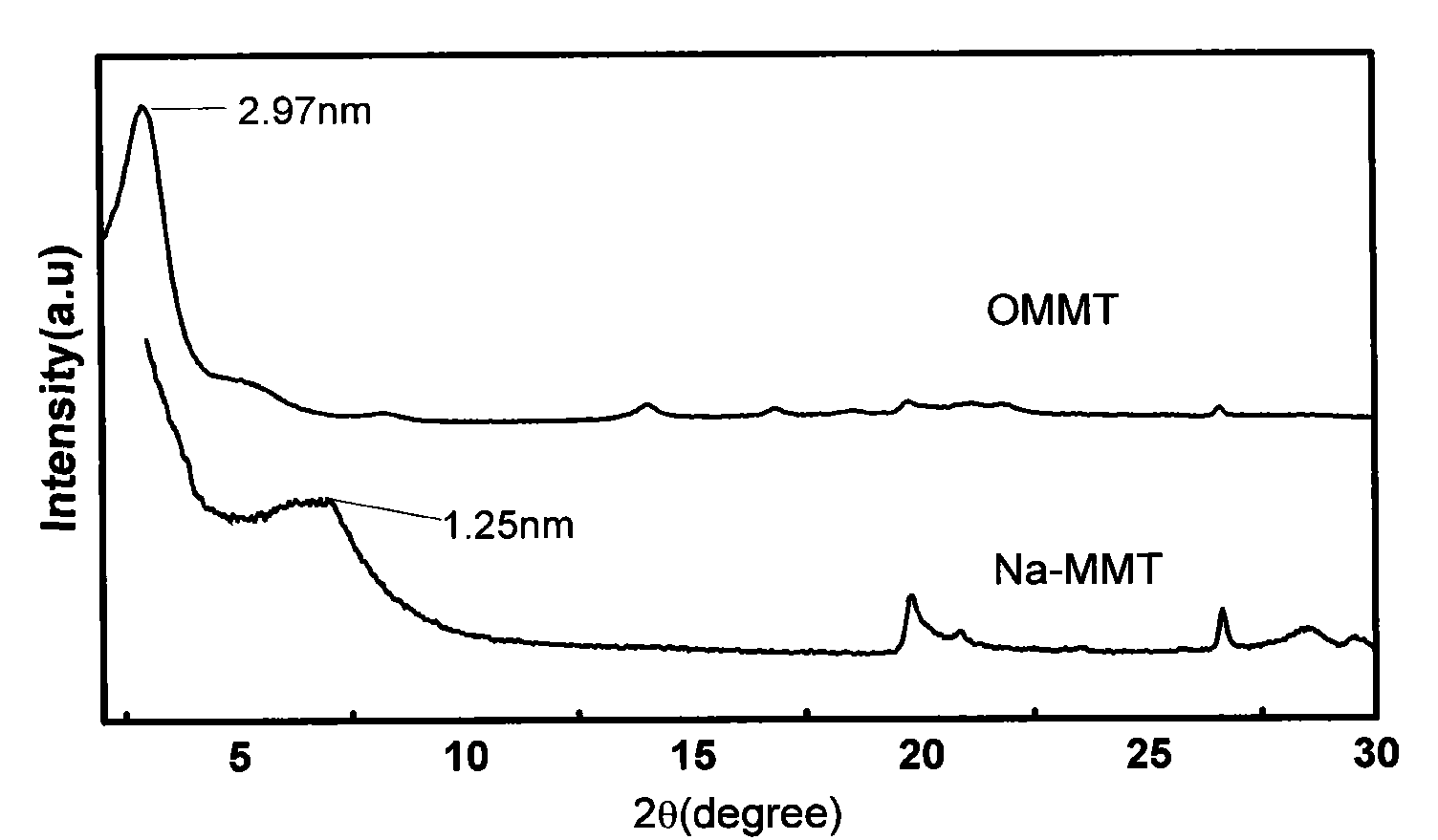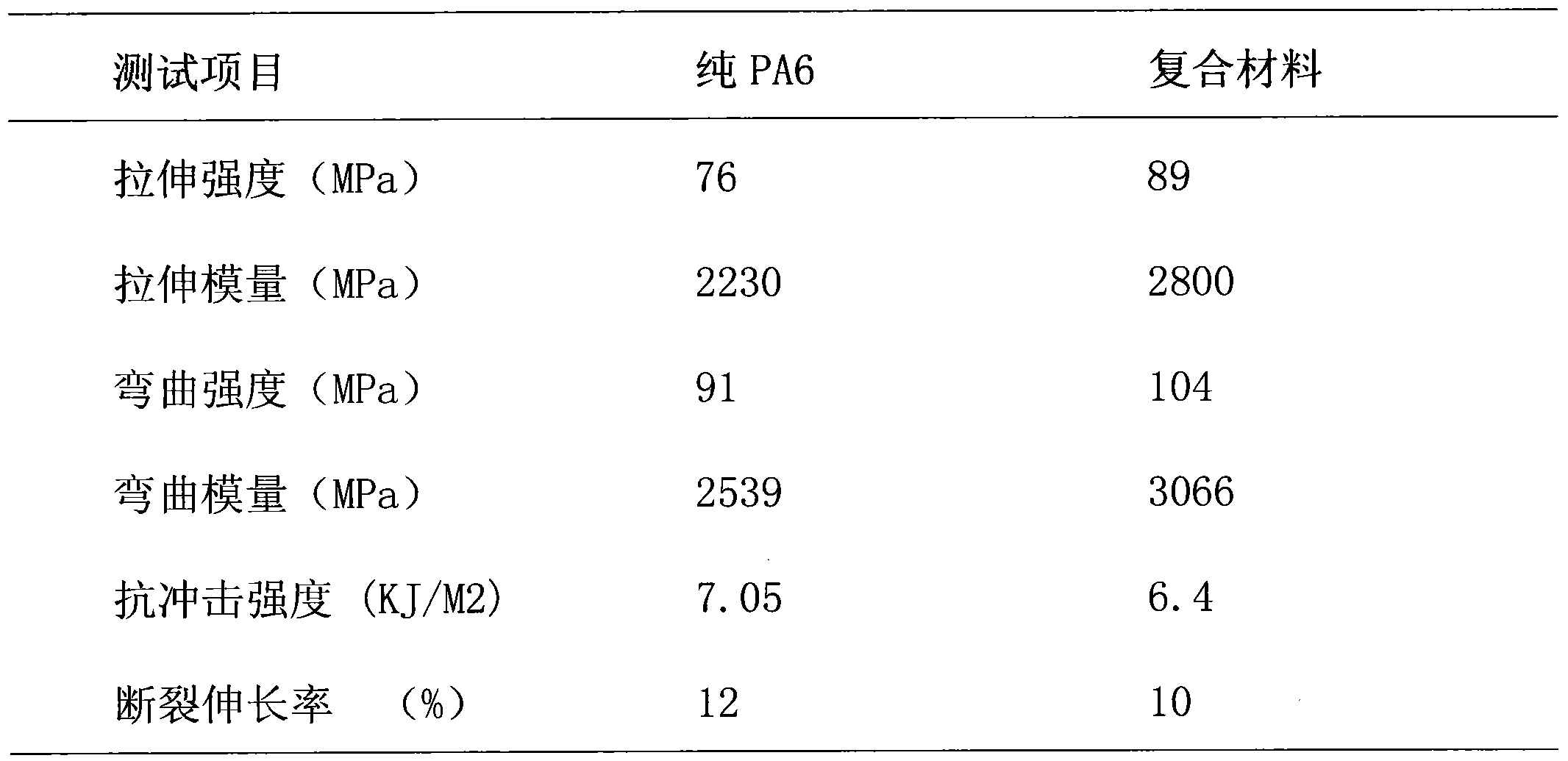Preparation method of organic montmorillonite for polyolefin composite material
An organic montmorillonite and composite material technology, which is applied in the field of preparing organic montmorillonite for polyolefin composite materials, can solve the problems of inability to increase the interlayer spacing of montmorillonite, unsuitable for industrial production, yellowing of plastic products, etc. Low cost, meeting color requirements, and improving product quality
- Summary
- Abstract
- Description
- Claims
- Application Information
AI Technical Summary
Problems solved by technology
Method used
Image
Examples
Embodiment 1
[0037] In the first step, 500g of sodium montmorillonite is weighed and placed in a reaction vessel (this product is provided by Zhejiang Sanding Technology Co., Ltd., brand 1095B, CEC is 98mmol / 100g, and the water dispersion particle size D90 is 8.61 μm);
[0038]In the second step, weigh 178.94g (100mmol / 100g, 1.02 times of CEC) dodecyldimethylbenzyl ammonium chloride salt (content is 95%) into a 1:1 ethanol solution, heat and stir until completely dissolved .
[0039] Step 3: Weigh 50 g of hydrophobic nano silicon dioxide (provided by Anhui Jingye Nano Technology Co., Ltd., D90≤25nm) into a 1:1 ethanol solution, and form a suspension after high-speed stirring.
[0040] In the fourth step, pour the dissolved quaternary ammonium salt solution in the second step into the montmorillonite powder in the first step, stir, and add 5 kg of hot water with a temperature of 80°C, continue stirring at a high speed, and the reaction time is 20 minutes, the temperature is 80°C.
[004...
Embodiment 2
[0045] In the first step, weigh 500g of sodium-based montmorillonite (provided by Zhejiang Sanding Technology Co., Ltd., brand 1090B, with a CEC of 92mmol / 100g and a water-dispersed particle size D90 of 9.82 μm);
[0046] In the second step, weigh 178.94g (100mmol / 100g, 1.08 times CEC) dodecyl dimethyl benzyl ammonium chloride salt (content is 95%) into a 1:1 ethanol solution, heat and stir until completely dissolved .
[0047] In the third step, 100 g of amphoteric nano-silica (provided by Anhui Jingye Nano Technology Co., Ltd., D90≤25nm) was weighed into a 1:1 ethanol solution, and a suspension was formed after high-speed stirring.
[0048] In the fourth step, pour the dissolved quaternary ammonium salt solution into the montmorillonite powder, stir, and add 5 kg of hot water at a temperature of 70°C, continue stirring at a high speed, the reaction time is 20 minutes, and the temperature is 70°C .
[0049] The fifth step, then pour the silica suspension into the organic mo...
Embodiment 3
[0051] The first step, weigh 500g Na-based montmorillonite (provided by Zhejiang Sanding Technology Co., Ltd., brand 1095B);
[0052] In the second step, weigh 134.69g (100mmol / 100g, 1.02 times CEC) dodecyltrimethylammonium chloride salt (98% content) into a 1:1 ethanol solution, heat and stir until completely dissolved.
[0053] The third step is to weigh 50 g of hydrophobic nano silicon dioxide (provided by Anhui Jingye Nano Technology Co., Ltd., D90≤25nm) into a 2:1 ethanol solution, and form a suspension after high-speed stirring.
[0054] The fourth step is to pour the dissolved quaternary ammonium salt solution into the montmorillonite powder, stir, and add 5 kg of hot water with a temperature of 85°C, and continue stirring at a high speed. The reaction time is 20 minutes, and the temperature is 85°C .
[0055] In the fifth step, pour the silica suspension into the organic montmorillonite slurry, and continue stirring at high speed for 20 minutes; finally, the slurry is...
PUM
| Property | Measurement | Unit |
|---|---|---|
| particle diameter | aaaaa | aaaaa |
| particle diameter | aaaaa | aaaaa |
| particle diameter | aaaaa | aaaaa |
Abstract
Description
Claims
Application Information
 Login to View More
Login to View More - Generate Ideas
- Intellectual Property
- Life Sciences
- Materials
- Tech Scout
- Unparalleled Data Quality
- Higher Quality Content
- 60% Fewer Hallucinations
Browse by: Latest US Patents, China's latest patents, Technical Efficacy Thesaurus, Application Domain, Technology Topic, Popular Technical Reports.
© 2025 PatSnap. All rights reserved.Legal|Privacy policy|Modern Slavery Act Transparency Statement|Sitemap|About US| Contact US: help@patsnap.com


